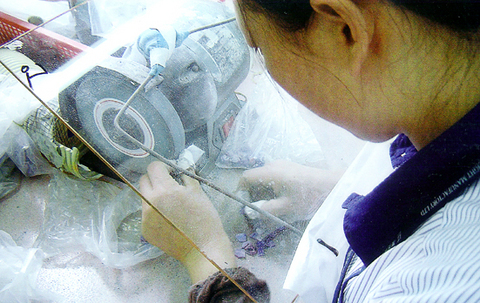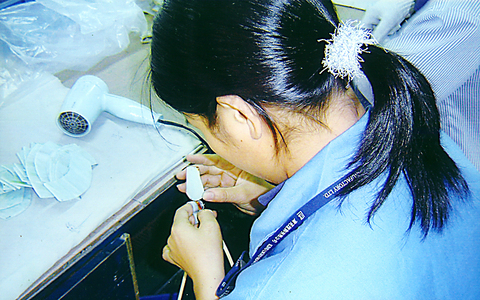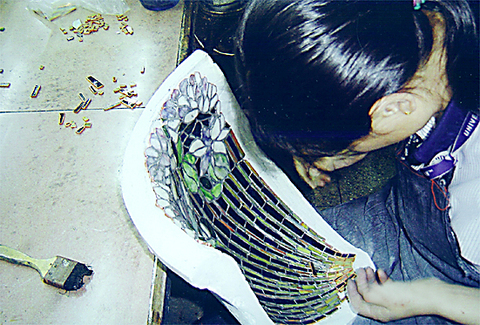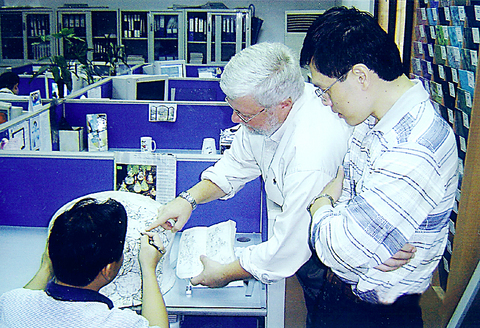When Louis Comfort Tiffany first fashioned lamp shades from cut glass, his stated purpose was to bring good art to American homes.
Yeh Ching-hung (
As the owner of the Tiffany Lighting company on Xinyi East Road and the sole importer of Tiffany lamps to this country, Yeh hopes to popularize the uniquely US handicraft in a nation fixated on fluorescent fixtures. Given that Tiffany himself died considerably poorer than when he was born, Yeh has his work cut out for him.

Tiffany's middle name was no joke. He was born the eldest son of Charles Lewis Tiffany, the founder of Tiffany and Co Jewelers. From a young age, he knew that he wanted to study art rather than take the helm of his father's jewelry empire. He took up the brush and enjoyed success as a painter even in his early years, but sometime in the early1880s he began focusing on interior design.
Having grown up on an estate, Tiffany loved nature and his art reflected his love. His paintings, stained glass windows, partitions, and later his lamp shades, would nearly always have nature motifs in them; leaves, flowers and his favorite, dragonflies.
Tiffany saw stained glass windows and screens as the natural evolution of painting and a medium that could bring art into people's living rooms. Unlike wall-hangings, glass could spill colored light onto the floor, bringing a space alive. At first he worked with existing glass but soon began studying how to make his own and make it in bolder colors than had previously been possible. His own patented glass production methods would become known as Favrile.

Then in 1885 a watershed event would occur. While designing lighting fixtures for the world's first wired theater, the Lyceum in New York, Tiffany was encouraged by Thomas Edison to create shades for table lamps. The job was such a success it had him designing interiors for many of the wealthiest homes in America and even in the White House.
Ever an innovator, Tiffany was constantly at the furnace firing new colors and textures of glass. Even when many of his highly-skilled glass blowers would deem a particular experiment a failure, Tiffany would continue trying. The money he spent making new types of colored glass would eventually eat through much of his US$35 million inheritance. In 1913 he retired from the company he founded and died 20 years later.
Although Tiffany glass lamp shades were originally crafted exclusively in the US, several factories have been established in China, where both lower manufacturing costs and a higher-quality material are found.

The material is jade. Dug from the hills of Shenzhen, the opalescent white to dark green stone is cut and ground to pieces thin enough for light to pass through. These lamps have found an audience back in the US and in both China and Taiwan. Though the stone is more expensive to work with than glass, cheaper labor helps keep the lamps affordable.
"Many Taiwanese don't consider buying these kinds of lamps because of their price," Yeh said. "And because they'd rather spend the money redecorating in a few years' time. What they often don't understand is that these lamps are heirlooms that appreciate in value."
In 1998, Yeh pointed out, two lamps made by Tiffany himself sold for more than US$2 million. At appreciation rates like that, he said, it's a wonder there isn't a Tiffany lamp in every home in Taiwan.


PHOTOS COURTESY OF YEH CHING-HUNG

The canonical shot of an East Asian city is a night skyline studded with towering apartment and office buildings, bright with neon and plastic signage, a landscape of energy and modernity. Another classic image is the same city seen from above, in which identical apartment towers march across the city, spilling out over nearby geography, like stylized soldiers colonizing new territory in a board game. Densely populated dynamic conurbations of money, technological innovation and convenience, it is hard to see the cities of East Asia as what they truly are: necropolises. Why is this? The East Asian development model, with

June 16 to June 22 The following flyer appeared on the streets of Hsinchu on June 12, 1895: “Taipei has already fallen to the Japanese barbarians, who have brought great misery to our land and people. We heard that the Japanese occupiers will tax our gardens, our houses, our bodies, and even our chickens, dogs, cows and pigs. They wear their hair wild, carve their teeth, tattoo their foreheads, wear strange clothes and speak a strange language. How can we be ruled by such people?” Posted by civilian militia leader Wu Tang-hsing (吳湯興), it was a call to arms to retake

This is a deeply unsettling period in Taiwan. Uncertainties are everywhere while everyone waits for a small army of other shoes to drop on nearly every front. During challenging times, interesting political changes can happen, yet all three major political parties are beset with scandals, strife and self-inflicted wounds. As the ruling party, the Democratic Progressive Party (DPP) is held accountable for not only the challenges to the party, but also the nation. Taiwan is geopolitically and economically under threat. Domestically, the administration is under siege by the opposition-controlled legislature and growing discontent with what opponents characterize as arrogant, autocratic

Desperate dads meet in car parks to exchange packets; exhausted parents slip it into their kids’ drinks; families wait months for prescriptions buy it “off label.” But is it worth the risk? “The first time I gave him a gummy, I thought, ‘Oh my God, have I killed him?’ He just passed out in front of the TV. That never happens.” Jen remembers giving her son, David, six, melatonin to help him sleep. She got them from a friend, a pediatrician who gave them to her own child. “It was sort of hilarious. She had half a tub of gummies,